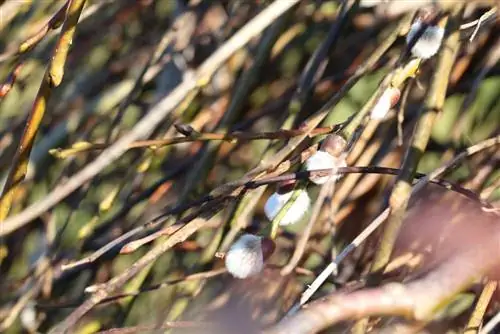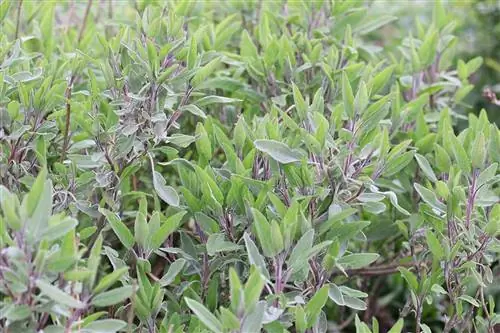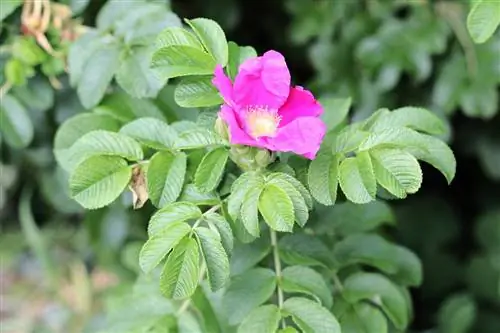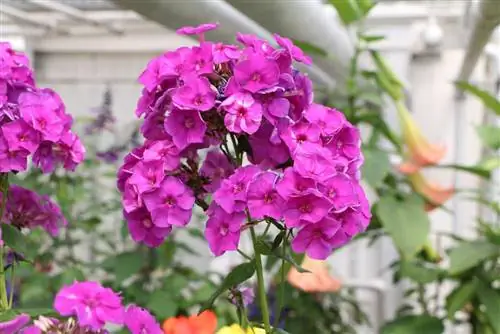- Author admin [email protected].
- Public 2023-12-17 03:39.
- Last modified 2025-06-01 06:48.
The protected palm catkins are a must for every hobby gardener, because if they are cultivated in your own garden, the species can be preserved. The bushes with the soft seed heads, which are reminiscent of a cat's fur, became known, especially in earlier years, when they were still found in large quantities on the edge of the forest or on embankments. But today the ornamental shrub is rather rare. One more reason to cultivate the easy-care plants that herald the approaching spring in the garden or on the terrace.
Location
Due to their previous wild growth in the wild, it can be seen that the catkins do not want any special features in their location. However, they still need enough sun and brightness. Therefore the ideal location looks like this:
- sunny to partially shaded
- also in a central spot in the garden on the lawn
- are often used as a privacy screen on a fence
- can tolerate a lot of water, therefore also suitable for pond edging
- in a sufficiently large bucket on the terrace
Tip:
Since the catkins only grow between 80 cm and 1.50 meters tall, they are ideal for any place in the garden and on the terrace.
Substrate & Soil
The catkin doesn't have any great demands on the ground either. However, this should be water-retaining so that there is always enough moisture. Therefore, loamy garden soil is the perfect soil for the catkin. In most gardens this is the existing soil. If there is not enough clay and the soil is too dry and crumbly, clay can be mixed in. However, the soil should not be too calcareous.
Watering & Fertilizing
The catkin prefers a lot of moisture. Therefore, watering must be carried out regularly and the soil should always be kept moist. This is particularly important to take into account in a hot summer as well as in a longer dry period in the winter. Shrubs cultivated in pots in particular should not be neglected when watering, as the soil can dry out more quickly due to sunlight or heat. When watering and fertilizing, pay attention to the following:
- Use low-calcium water
- collected rainwater is ideal here
- Use long-term fertilizer for green plants and shrubs
- add compost twice a year
- start the first fertilization early in late winter
Plants

The graceful catkins are available in stores all year round and can therefore be planted at any time. Since it is a very robust plant that can survive well in nature without much care, it also grows quickly after planting if it is provided with the right environment. Once the perfect location has been determined, planting can begin, which should be done as follows:
- dig a hole big enough
- To avoid waterlogging, create a drainage system on the floor
- use stones, gravel or pottery shards
- Place the plant carefully
- Root ball should be watered well in a bucket beforehand
- fill the prepared soil all around
- press lightly
- pouring
Tip:
The fluffy and soft palm catkins are not only a highlight in every garden for the eye of the beholder, the flowers that bloom very early in the year also invite the first insects to feed.
Plants in a pot
If there is no garden or enough space for a bush in the bed, the catkin can also be easily cultivated in a pot. A clay pot is the best solution for this because it stores the moisture that the shrub desires. It is therefore important to have good potting soil for potted plants that stores water well but also releases it. When planting in a pot, you should proceed as follows:
- Despite the desire for a lot of moisture, avoid waterlogging
- Create drainage over the drain hole
- for this purpose, pebbles or stones are placed over the hole
- cover everything with plant fleece
- so earth can't block the drainage
- Enrich potted plant soil with a little clay
- put part of the soil in the bucket
- Water the root ball of the plant in a bucket of water
- Remove palm catkins from the water and insert carefully
- fill up the remaining soil
- press lightly
- water moderately
- Remove excess water from the saucer half an hour after watering
Tip:
If you have a cutting from a catkin, you can also use it directly in the pot for rooting. As a rule, a new bush develops after a short time.
Repotting
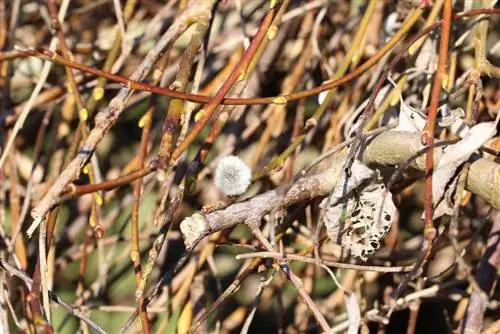
If the catkin is cultivated in a pot, it must be repotted regularly because the shrub always needs enough space. The ornamental shrub should therefore be given a new, larger pot every two or three years. Another advantage of repotting is that the soil in the bucket can be renewed. If a larger pot is not required, the substrate can be completely replaced and the plant can be reinserted into the old, existing pot with fresh soil. If the plant is carefully removed from the old pot, it can absorb fresh water until it is placed in a bucket. Otherwise, the procedure for repotting is the same as for planting in a bucket.
Propagation by cuttings
Palm catkins are easy to propagate. Hobby gardeners who already have one or two bushes in the garden can use the branches left over from cutting or cut off one or two branches specifically for propagation. However, since the catkins are protected, it is forbidden to break or cut branches of wild plants. However, some hobby gardeners do this despite everything because they want to use the branches for propagation and thus to preserve the graceful plant. However, if you just want to put the branches in the vase at home, you should only use those from your own plants. When propagating, you can then proceed as follows:
- do not throw away the cuttings in spring
- use beautiful, straight branches from this
- these can be used as cuttings
- simply stick the branches directly into the ground
- about 10 - 15 cm deep
- Roots form after just a few days
- small pots can be used for this
- Transplant to the intended location after a few weeks
- As a rule, rooting can also be achieved directly at the desired location
- Water cuttings regularly so that roots can form
Tip:
Every gardener should bring this early beauty into their garden, because after a long winter, the catkins are among the first plants to bloom. They got their name from their flowers, they look like cat fur and usually bloom at Easter time.
Propagation by seeds
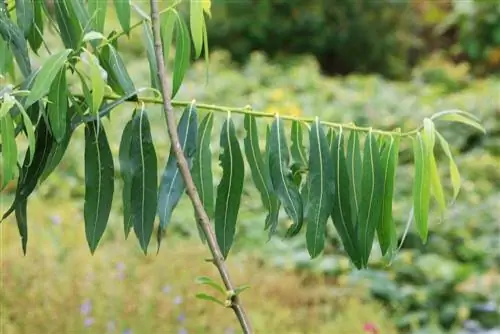
Of course, palm catkins can usually also reproduce themselves through seeds. However, sowing seeds is not recommended for hobby gardeners, as propagation via cuttings is so easy. But of course the seeds that form in the flowers can also be collected and prepared for sowing. The procedure is as follows:
- Seeds should not be stored
- collect these from the tree
- place immediately in loose and moist soil
- use a small pot with potting soil for this
- keep the soil always moist
- The first seedlings should be visible after just 24 hours
- you can see the small plants, prick them out
- that means each plant should have its own pot to grow in
- If the new palm catkins are big enough and have roots, put them outdoors
- Alternatively, these can also be cultivated in a larger container
- After four years, these new plants are also fertile again
Tip:
If you don't yet have one of these decorative shrubs in your garden to use the seeds, you can also collect them in nature from free-standing catkins.
Cutting
Palm catkins are usually cut after early flowering in spring. This pruning is definitely recommended, regularly every year, otherwise the bush will not develop properly and the flowering in the following year will only be moderate or not at all if no pruning has been carried out. The plant can be radically cut back so that only small remains of branches can be seen. However, since the shrub grows very quickly, this condition does not last long. In this way, the hobby gardener also receives many new cuttings for other shrubs. When cutting the catkins you should therefore proceed as follows:
- Use sharp secateurs
- disinfect these in advance
- shorten branches widely
- only a thickening about the size of a fist should be visible at a fork
- Rotate plants grown in pots regularly
- so they grow evenly against the light after cutting
- the newly growing bush becomes dense and straight all around
Wintering
Palm catkins are among the hardy shrubs. Therefore, they do not require any special measures for the winter as long as they are cultivated in a garden bed. Plants in pots should still be protected at their roots. To do this, the bucket is placed on a Styrofoam plate and wrapped all around with plant fleece or with jute for a better view. There is also a layer of mulch or leaves on the surface of the soil. This also protects the soil from drying out. Alternatively, if there is enough space in the garden bed, the catkins can also be planted together with the pot, or removed from the pot, in a garden bed for overwintering. The water supply must also be ensured in winter. The plants remaining in the pot need to be watered regularly, but the shrubs in the bed only need to be watered during longer, dry, cold periods.
Care errors, diseases or pests

A care mistake can definitely be made if too little is watered and the catkin does not find enough moisture in the soil. Then the bushes like to let their branches hang. But as soon as this error is corrected, they straighten up again and sprout again. Willow rust can also affect the shrub. It is particularly important that all fallen leaves are cleared away and that infected leaves that are still on the bush are removed immediately. Willow rust is a fungal disease that manifests itself as bright orange spots on the leaves. This can be prevented with plant strengtheners and a good supply of nutrients. A regular application of fertilizer in conjunction with a fungicide usually provides relief if an infestation has been identified.
Tip:
Do not dispose of removed, infected leaves and the trimmed leaves from the ground in the compost, as this allows the fungus to develop further and may come into contact with other plants the next time fertilizer is added. Therefore, dispose of the waste with household waste or green waste.
Conclusion
Palm catkins are beautiful early bloomers and therefore the first messengers in spring, which also offer insects a source of food immediately after winter. They also remind many hobby gardeners of their childhood, when the graceful bushes still grew along the side of the road and announced the approaching Easter with their furry flowers. The shrubs are very easy to care for, multiply quickly and are hardy, making them the right shrub for the garden bed or in the pot on the terrace and balcony for hobby gardeners with little time for care.

